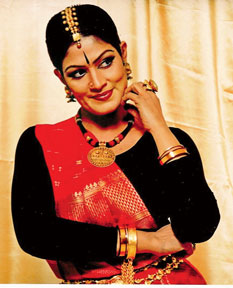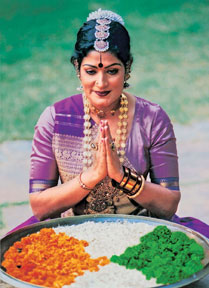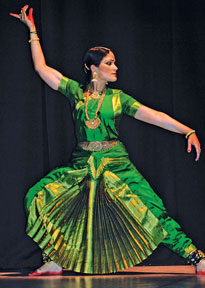|
Interview:
A divine amalgam between music and dance
By Ranga CHANDRARATHNE
Having learnt and practised the age-old tradition of Bharatanatyam
under luminaries in the field such as gurus Swarna Saraswathy, Vazhuvoor
V Sadasivam, K N Dakshinamurthi and Padmashri Geeta Chandran stirs her
own course in the arena of performing arts infusing her own vision,
grammar and vocabulary of dance.
 It is not only a journey of discovery and excellence in carrying the
legacy to proscenium stage but also effectively use Bharatanatyam as a
potent tool of communication to address social issues such as social
stigma and feticide. At her hand, Bharatanatyam is not only a tool of
communication but also a tool of education and social empowerment.
Besides being an accomplished Bharatanatyam performer, Geeta Chandran is
a highly acclaimed Carnatic singer. It is not only a journey of discovery and excellence in carrying the
legacy to proscenium stage but also effectively use Bharatanatyam as a
potent tool of communication to address social issues such as social
stigma and feticide. At her hand, Bharatanatyam is not only a tool of
communication but also a tool of education and social empowerment.
Besides being an accomplished Bharatanatyam performer, Geeta Chandran is
a highly acclaimed Carnatic singer.
Excerpts of an interview with Geetha Chandran
Question: As early as five years, you have come under the
influence of your Guru Swarna Saraswathy, who hailed from the
traditional Thanjavoordevadasiparampara and Bharatanatyam has become a
part and parcel of your life. How do you perceive the influence of your
Guru on you in evolving your philosophy of Bharatanatyam as a performing
art?
Answer : My first teacher was Srimathy Swarna Saraswathy. I
think she was now looking back at a piece of history because she had
seen the entire transition of Bharatanatyam from temple tradition into a
proscenium art form.
Unconsciously at the age of six my mother took me to learn
Bharatanatyam under her. She was an artist who could dance and sing for
three hours and she could play the Veena. So, she had the
multi-dimensional approach to arts. So we thought that we had to do all
these forms of art if we wanted to be a dancer. The whole idea of just
moving your arms and legs or just learning to dance was not good enough.
Enriching
I started learning music at the age of seven. This holistic learning
process was very enriching. For us, a class was not time-bound and we
used to go around 3.30-4.00 to the class and used to watching our
seniorsí class and then it became our class. When the junior students
came we used to teach them. So ,it was a long process not just like
today where you watch the clock and after one hour would say Namaskaram
(Please leave).
 Three or four times a week, we did this ritual without realising
dancing became a part and parcel of our whole being. What was
interesting also was the fact that performing was never important. We
never learnt the art with stakes that I think is an important thing she
taught us. Three or four times a week, we did this ritual without realising
dancing became a part and parcel of our whole being. What was
interesting also was the fact that performing was never important. We
never learnt the art with stakes that I think is an important thing she
taught us.
The process of learning is that what enriches the artiste not
performances. Performances are just an outcome. It can work and it
cannot work and it does not matter. And the whole spiritual ethos of
dance is that you donít dance for an audience but you dance for yourself
and itís a dialogue between you and the divine. I think all those
constructs is what my first teacher gave me and which has really shaped
my whole outlook to dance.
Q: Apart from being a principal exponent of Bharatanatyam, you
are also an accomplished Carnatic vocalist. How would you describe this
aesthetic amalgam between Bharatanatyam and your abiding interest in
Carnatic music?
A: Because of first dance teacher, as I said earlier, music
was integral. I started my initial training in music under Shrimathi
Meera Seshadri. She was also singing for my dance. So there was a
connection between the music that I learnt, the traditional Carnatic
music and dance. It was a fact that she sang for my dance. Every nuance
that you sang had to be translated into dance. And that was the
philosophy.
If you took a Sanghathi that should be reflected in dance.
Resonance
It is not as though you just ask the musician the number of phrases
to be sung and you do your bit which is choreographed. It has to have a
definite resonance of what the singer sings. For me, poetry, dance and
movements are inseparable and they have to be seen as a holistic
experience and it cannot be divorced from one another.
 I have had 20 years of training in music. After Meera Seshadri, I was
under the guidance of Sri Gopalaiyer and Shankara Sharma. At one point,
I had the dilemma of whether to take up music or dancing as a career.
But I think my dance teachers prevailed upon me and they were very
insistent and I came into dance. I have had 20 years of training in music. After Meera Seshadri, I was
under the guidance of Sri Gopalaiyer and Shankara Sharma. At one point,
I had the dilemma of whether to take up music or dancing as a career.
But I think my dance teachers prevailed upon me and they were very
insistent and I came into dance.
Q: While continuing the age-old tradition of Bharatanatyam,
you have attempted to imprint Bharatanatyam with your vision
synthesising the knowledge you have acquired from diverse Gurus. What
are the contours which of your philosophy of Bharatanatyam?
A: Well. One cannot define oneís own philosophy because itís
what you practise and it is hard to put it into words. I think
aesthetics has been the major guiding force. Respecting tradition and
yet pushing the frontiers of tradition of the grammar of dance and to
see what happens to it and to explore solo work and explore group work.
But, when we teach we do not dilute or experiment at all because
reference point has to be clearly established for the students. So, when
we teach we do not bring in otherwise our experimental work.
We teach the traditional repertoire or the Margam with theory and the
practice. But my own work is, I think, at two levels; one is to extend
and expand the traditional repertoire and the second is to do
experimental work which could be collaboration with some other art
forms. It may relate to certain theme or any other experimental work.
Q: Logical extension and the application of your vision on
Bharatanatyam is the founding of Natya-Vriksha, an organisation
dedicated to preserving and promoting Bharatanatyam. How would you look
back on Natya-Vriksha and its contribution over the years to the
preservation and propagation of Bharatanatyam in modern context?
A: I started teaching under my Guru at his own institute in
Delhi. I was actually trained in teaching dance. I used to sit beside
him and take up the class and he used to correct me. Under his guidance
I started to teach and Natya-Viriksha came into being 20 years ago.
 It has been a wonderful journey with my students as I was able to
mentor them at diverse levels besides teaching dancing. It has been a wonderful journey with my students as I was able to
mentor them at diverse levels besides teaching dancing.
Over the years I developed a good partnership and friendship with
them. Imparting Bharatanatyam has always been a pleasure; sharing
tradition and sharing the entire vocabulary of dance in todayís context,
I think, is a great challenge for any teacher because pedagogy has
constantly to be revisited and teachers will have to use teaching
methods to keep the studentís attention.
Q: You are also the artistic director of the NatyaVriksha
Dance Company which is known for its highly classical performances.
Would you elaborate on the guiding principles and your practical
approaches to Bharatanatyam performances and creations by NatyaVriksha
Dance Company?
A: Well, the company came into being around the 1990s and we
just felt that exploring many bodies and spaces would be interesting.
But it did not come out of a pressure to engage in group work which, I
see, is, in many places where irrespective of whether the people are
qualified or not they jump into group work.
Group is a different area unlike sole dancing and one needs to
unlearn many things to be in a group. We went into group work
(performance) 10 years ago and since then, we have been learning through
our mistakes. It is an interesting to work with my students in
professional manner and each and every production is well-rehearsed. And
we have been appreciated for coordination, music, and costume design and
even for lighting. In fact, the group handles every aspects of the
production from costume designing to lighting.
Vision
Q: In accordance with your vision, you have continuously
engaged in expanding the frontiers of Bharatanatyam with the intention
of creating spaces for it in modern context and reach out for,
particularly, young audience. Would you believe that Bharatanatyam is an
art which should be linked to life and Bharatanatyam can function as a
social bridge builder, thereby making a difference to life?
A: Yes, Bharatanatyam is a way of life. My students whether
they are accountants, lawyers or professional marketeers, they have
excelled in their chosen fields and they are better human beings because
they have gone through traditional rigours of dancing.
They also respect their culture more than those who have not had a
formal education in India. I think that they are blessed to be exposed
to art. I feel whatever they do they do it with a different sensitivity
and different sensibility, a fact which I have observed over the past 20
years.
I think Bharatanatyam is a potent communication tool if you really
donít see it as a mere traditional performing art. So, it is possible
with that vocabulary to effectively convey any message. For instance if
we hold a seminar on subjects such as war or violence, speeches can be
made for ten hours, sometimes a ten minute presentation would be much
more effective than words. I think that communication aspect of
Bharatanatyam should be more and more explored especially in the present
context as there is no perfect audience; itís full of violence, stress
and negative energy. So I believe that dance creates positive energy and
creates those bridges.
Q: In an unprecedented manner, you have used your creations to
address social issues such as social stigma, female feticide and gender
and environmental issues. How would you look at your creations such as
dance-theatre production Kaikeyi, choreographies on the themes of drugs
and mythologies retold and their impact on society?
Objectives
A: We attempted to achieve diverse objectives through dance.
Some productions have been collaborative initiatives while we have been
commissioned to perform on a given subject. About 15 years ago, we were
asked to make a production on women and war and the presentation was
entitled Her Voice. It was a collaborative presentation of puppets and
dance. It travelled far and wide and was received highly positive
reviews.
The presentation deals with the latter part of the life of Draupadhi.
She suffers terrible losses when her children and relations were killed
in the war. As a reaction to the news of deaths of her relatives, she
says muchati muchati (forget and forget). She says I am the one who
started this cycle of violence and now let us break it as war does not
solve anything.
We tried to deal with social stigma through the character of Kaikeyi.
Kaikeyi is a character from Ramyana and she is supposed to be a black
character so no girl is named after her.
We revisited her and a series of events from Ramayana were adapted
into a dance drama. Then we did a production entitled Mythologies Retold
on feticide. We created a story out of a contemporary myth for the
production.
Q: Apart from your role as a social activist, you have
authored So Many Journeys, a book about your life-long engagement with
Bharatanatyam and Dynamic Women Dancers (Womenís Hall of Fame series).
Would you expand on the themes and a kind of personal narratives that
made up So Many Journeys and Dynamic Women Dancers?
A: The book So Many Journeys is really made out of my own
teaching experiences and performing experiences. I wanted to leave
behind something for my students.
So, it is a compendium of my own experiences through a 30 year career
and the book also traces the evolution of dance, presentation and
audiences. Vara (The boon) is my first film project in which I act as a
Devadasi and the character involves a lot of dance and singing scenes.
An internationally renowned professional worked in the project as the
crew. |

